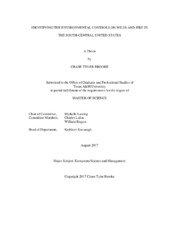| dc.description.abstract | Fires are responsible for the historical shape, structure, and composition of ecosystems in the South-Central United States. The biophysical settings in which fires readily occur are affected by global processes like climate change, as well as local and regional characteristics like vegetation structure, proximity to human infrastructure, and topography. The increasing number and severity of fires today requires high-resolution and accurate predictions of fire probability. The use of species distribution models (SDM) has allowed researchers to identify predictive environmental characteristics of fire, and depict the probability of fire occurrence. I applied a Maximum Entropy (Maxent) SDM to identify fire predictors and fire risk in Texas; an ideal test case for the South-Central US. To this end, I used 15 years (2001-2016) of remotely-sensed fire occurrence data, along with 13 biophysical variables representing climate, terrain, landcover, and human activity to generate multiple models. Models were generated at the state and regional level to identify the impact of scale on fire predictions. At the state level, annual precipitation was the most important predictor of fire occurrence, with elevation and landcover following. At the regional level, precipitation was consistently a top predictor of fire, though the influence of other predictors varied from region to region. In more arid regions, precipitation was the most significant predictor of fire; while in wetter regions, terrain and landcover had higher predictivity. When comparing the Maxent fire prediction outputs, the regional level analysis had more variance in prediction, whereas, at the state level, the predictions were less variable. When projecting fire probability in future climate conditions, the degree of fire probability did not drastically change. The central portions of the state had higher probabilities of fire occurrence while the coastal and high plains regions of the state predicted lower probabilities. In the South-Central US, and Texas in particular, the importance of precipitation in driving fire occurrence is significant. Human activity was also a predictor of fire in less populated areas, though a consistent pattern was not apparent. Overall, Maxent allows for useful modeling of fire probabilities and provides new insights into predictors of fire occurrence within this region. | en |


